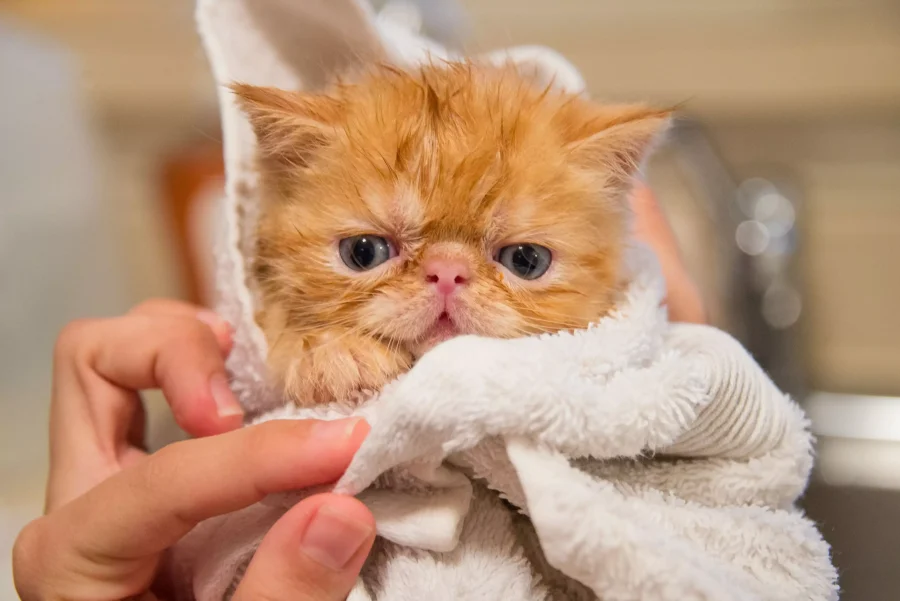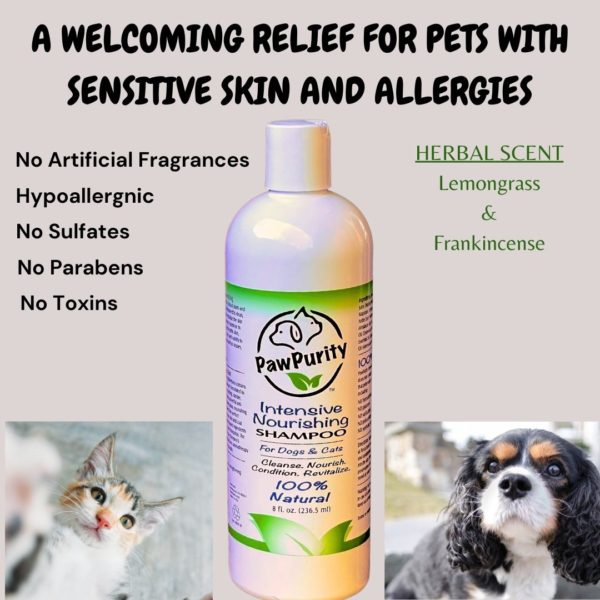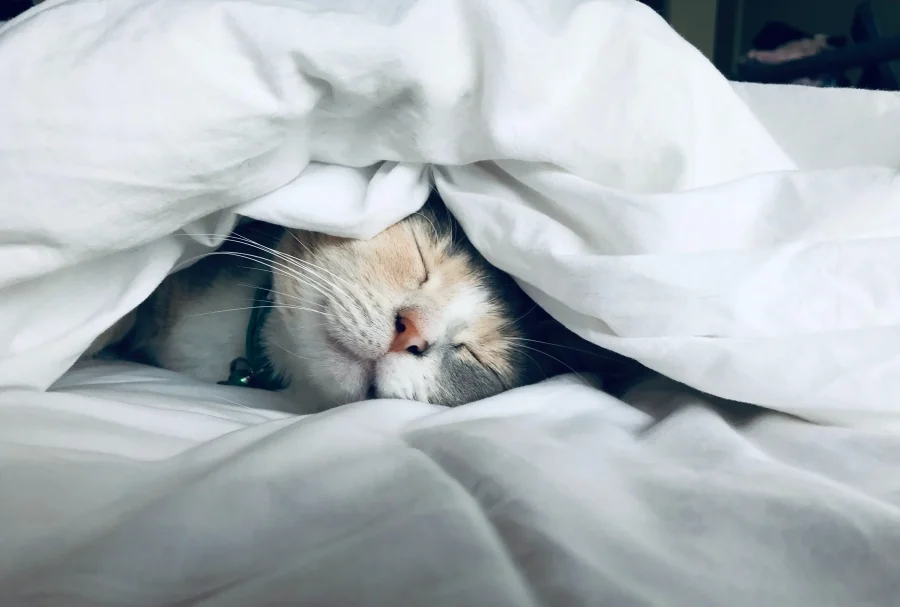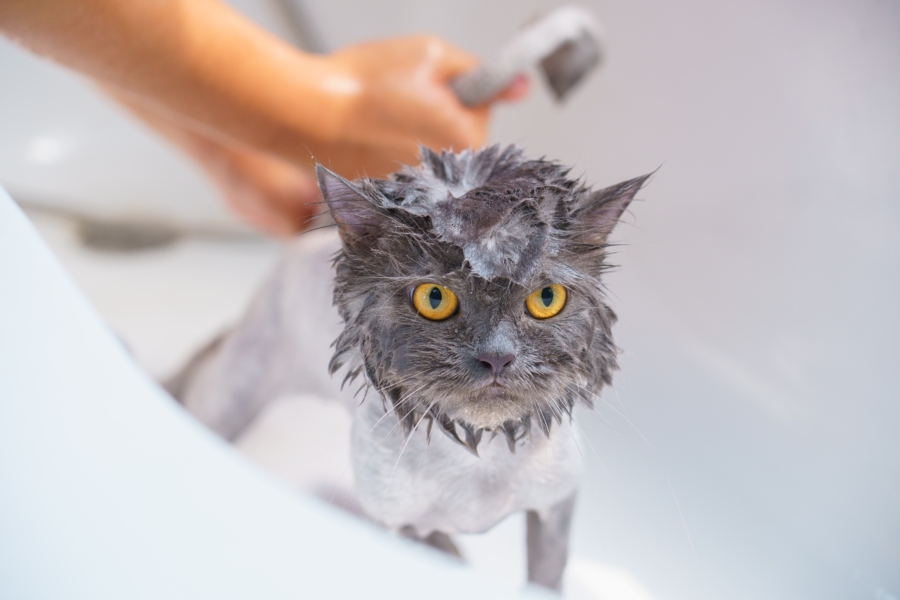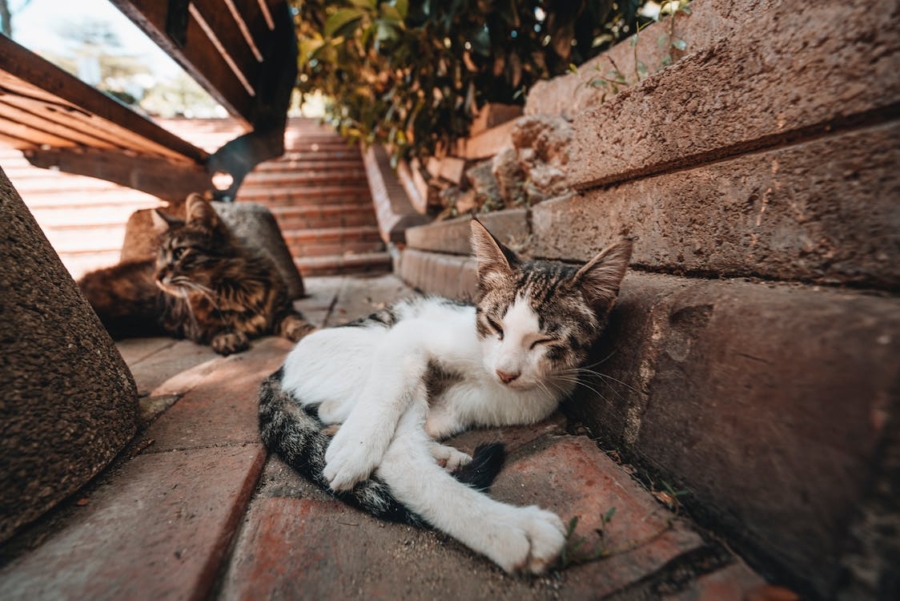Select a cat shampoo based on your cat’s skin condition. Discover which one to choose.
Cat Skin Issues and Suitable Shampoo Solutions
Cats are prone to several skin problems, from allergies to infections. And while there are many shampoos on the market, finding the right one for your cat’s particular skin and fur issues can be challenging. Here are some of the most common cat skin problems and the best shampoo ingredients to treat them.
- Dry Skin
If your cat has dry skin, you’ll want to use shampoo to hydrate and replenish its coat. We recommend trying one chock full of antibacterials, anti-inflammatories, vitamines C, B & E, and conditioners. Look for shampoos that are good hydrators and moisturizers. Experts say the leading cause of dry skin is the shampoo used. Remember, your cat’s skin is its largest organ. It’s the barrier for keeping out bacteria, fungus and disease. Dry skin means your cat is suffering from skin damage, which in most cases may be fixed simply by changing shampoo. PawPurity’s Intensive Nourishing Shampoo has been known to reduce significantly and, in most cases, eliminate dry skin.
- Dander
Dander is a common problem in cats, especially those with dry skin. If your cat is dealing with dander, try using a natural shampoo to help clear it up. Also, search for anti-bacterial, antifungal and humectant (hydrating) ingredients in a shampoo, as this helps eliminate this particular skin issue. Look for a shampoo that conditions and keeps the moisture in. Zinc can help eliminate dander. PawPurity offers a shampoo specific to this problem, Biogreen Enriched Shampoo.
- Itchiness and Inflammation
If your cat has itchiness or inflammation, it can easily be caused by allergies. You’ll want to find a calming shampoo to help soothe its skin. You would have to look for shampoos that contain components such as like yucca root, chamomile and aloe vera. Nettle is another great ingredient for soothing and healing, as it contains Quercetin. Quercetin is a flavonoid, which can inhibit IgE-induced histamine release, which brings us to the possibility of your cat having allergies.
- Allergies
If your cat is allergic to something in its environment, it may develop itchy, red skin. A hypoallergenic shampoo can help to soothe its skin and relieve the itchiness. Red clover reduces inflammation and promotes healing. Eczema, psoriasis and rashes respond positively to it’s healing and soothing qualities. So can using a shampoo that is void of sulfates, parabens, DEA, SLS and other harsh chemicals. If possible, avoid chemical-based shampoos at all costs.
- Infections
Skin infections are common in cats, especially those with long fur. Look for a shampoo with antimicrobial, antifungal and anti-inflammatory properties. Olive oil has excellent anti-inflammatory agents, yucca root is a wonderful natural conditioner that helps prevent dander, aloe vera is a antibacterial, antifungal and anti-inflammatory and calendula is a powerful antimicrobial and anti-inflammatory. There are many ingredients in natural cat shampoos that can prevent or eliminate skin infections in cats, so it’s important to read the labels on any cleanser you are considering to make sure they do more than just clean.
- Shedding
Shedding is a natural process for all cats, but some shed more than others. In healthy cats, shedding is the natural process that allows your cat to rid itself of old, unneeded and/or damaged fur. Most cats experience one to two hair growth cycles yearly. This means they will shed all their hair at some point. Indoor cats have bouts of intense shedding near the warmer months to better regulate their body’s temperature. In particular, spring and summer are when cats shed the most. However, they also tend to shed consistently throughout the entire year. This level of shedding is normal so don’t be alarmed. There are many ingredients that can help with your cat shedding due to damaged fur. Lemongrass in your cat’s shampoo is a rich source of iron, the deficiency of which causes hair and fur loss. Horsetail is another favored ingredient because it has high mineral levels including silica and other nutrients such as potassium, manganese and selenium. It is an excellent hair strengthener and encourages hair growth. It’s perfect for a weak, brittle or damaged coat, which tend to create even more shedding than what’s caused by normal changing of the seasons.
What to Look for in a Cat Shampoo?
If you have a cat, you know it must be bathed occasionally. But did you know there is a big difference between human and cat shampoo? Using human shampoo on your cat can be harmful. So how do you choose the best shampoo?
Here are a few things to keep in mind:
- Cat shampoo is specifically designed to be gentle on their fur and skin. Human shampoo, even one meant for babies, is too harsh and can strip away the natural oils that protect your cat’s skin.
- Look for shampoo free of sulfates, parabens, and other harsh chemicals. These ingredients can irritate your cat’s skin and cause excessive dryness.
- Choose a 100% natural formula if your cat has sensitive skin or is prone to allergies. A lot of cat shampoo manufacturers tend to use the cheapest and easiest-to-obtain ingredients even when they could be at the expense of your furbaby’s skin health.
Be Aware of Toxic Ingredients!
Here are some potentially harmful ingredients found in some cat shampoos and the effects they can have on your cat.
- Sodium Laurel Sulfate (SLS) is a detergent commonly found in shampoos, soaps, and other cleaning products. It is known to cause skin irritation and eye problems in cats.
- Polyethylene Glycol (PEG) is another common ingredient in pet shampoos. It can cause vomiting and diarrhea in cats if they ingest it.
- Artificial fragrances can be harmful to cats.
Choose Cat Shampoos That Understand Your Cat’s pH Levels
When it comes to our feline friends, we want them to be happy and healthy, and part of that is keeping their fur clean and free of any build-up. But many people don’t realize that the shampoo you use on your cat can make a big difference in their overall health beyond the skin and coat.
You see, cats have a delicate pH balance, and using the wrong shampoo can throw that off. That’s why it’s so important to use a shampoo specifically developed for use by cats that won’t strip away their natural oils or upset their pH balance. The pH of cat shampoos also matters because it can affect how well the shampoo cleans your cat’s fur and skin. For example, a shampoo that has an excessively high or low PH level, won’t bode well with your cat’s natural makeup, and can affect how well your baby’s skin barrier functions and how easily it absorbs moisture.
Quick Questions
How often does your cat needs a bath?
Your cat’s grooming habits are one of the many things that make them unique. So how often should you bathe your cat? Here are a few things to consider when deciding how often to bath your cat:
- Their coat type – If your cat has a short, smooth coat, it will probably only need a bath once every few months. They may need one every month if their coat is long or thick.
- How much time they spend outdoors – Cats who spend more time outside will likely need baths more often than those who stay most of the time indoors. Depending on if the ingredients in your cat’s shampoo are nourishing and making the skin healthy as well as cleaning, every three weeks is fine if your pet allows it. If you live in am area where there are fleas and ticks, consider using PawPurity’s Flea & Tick Shampoo and Spray.
- How dirty their coat gets – If your cat’s coat tends to get dirty quickly, you may need to give them more baths than if it stays clean most of the time.
- If you have allergies, you should know that it could be caused by cat dander. This is because cat dander seems to attach to everything in the house. Plus, it typically stays in a house for four to six months. Your cat’s dander is more airborne than a dog’s. To keep your cat dander allergies under control will require bathing your precious one once a week. This may sound dreadful, however, it’s a realty. In this case you truly want to stick with the most gentle, natural shampoo you can find. Try PawPurity’s Intensive Nourishing Shampoo. You will see that your cat’s skin will keep getting increasingly more healthy and the dander will subside significantly.
What are the best ingredients for cat shampoos?
- Aloe vera
- Lavender oil
- Chamomile
- Yucca root
- Natural oils and minerals
- Red clover
Can we use dog shampoos for cats?
In most instances, the answer is no unless the bottle specifies. All ingredients must be safe for dogs and cats.
There are hundreds of cat specific shampoos on the market and many that are for cats and dogs. There is no reason to use a dog-only shampoo. Some of these shampoos may be highly toxic to your kitty and others simply just are not healthy for a cat’s skin and fur. An article written by The Humane Society of the United States suggests that:
“When bathing pets, use only shampoos formulated for the particular species and follow the directions. Do not assume shampoos for dogs are appropriate for cats unless the label specifies both species.”
Find out more about cat care
Flea & Tick Protection, Skin, Coat & Paw Care
Cat Dermatitis – Causes & Cures
by Lisa Porter
on Jan 05 2023
Are you a cat parent trying to figure out what is causing your sweet little kitty’s skin irritation? If so, you may be dealing with dermatitis – an inflammation caused most often by allergies. Thankfully, this common issue can usually be managed and cured at home with the help of natural and/or medicinal antibiotics and topical creams. In this blog post, we will discuss some common causes of cat dermatitis and various treatments that could provide relief for your feline friend.
Cat Health & Care
Benefits of a Natural Shampoo For Cats
by Lisa Porter
on Jul 19 2023
Cats are notorious for their self-grooming habits, spending a significant part of their day meticulously cleaning themselves. While their grooming skills are impressive, there are times when our feline friends might need a little extra help in the form of a bath. Using a natural shampoo specifically designed for cats can provide numerous benefits, not only for their hygiene but also for their overall health and well-being. In this blog, we will explore why cats need baths and how often, as well as the advantages of using natural shampoo for your furry companions.
Skin, Coat & Paw Care
Dander on Cats – Diagnosis & Prevention
by Lisa Porter
on Jun 10 2023
Dandruff, a common skin condition characterized by flaky, dry skin, can affect not only humans but also our feline companions. Addressing and treating dandruff in cats is crucial for their overall health and well-being. This blog aims to provide a comprehensive understanding of dandruff in cats, its diagnosis, and its prevention, offering valuable insights for responsible cat owners.





